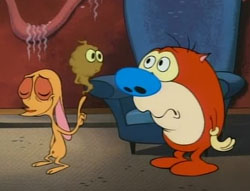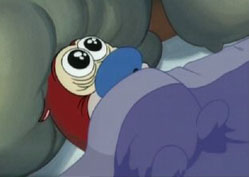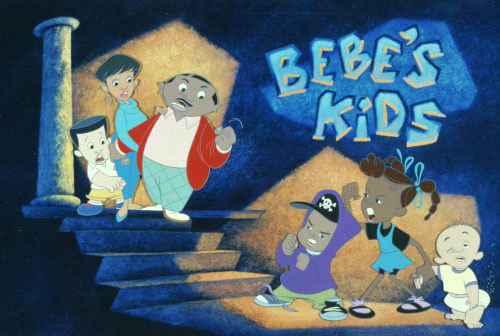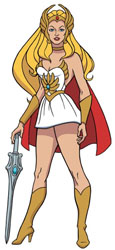 Son Of Stimpy. In The Hollywood Reporter for January 13, 1993, the trade paper reported on a press conference called by animator John Kricfalusi about his last Ren and Stimpy cartoon for Nickelodeon that was airing that night even though Kricfalusi had been fired in September. Originally entitled Stimpy’s First Fart, the title was changed to Son of Stimpy. Kricfalusi complained because he felt the entire story “depends on the title”.
Son Of Stimpy. In The Hollywood Reporter for January 13, 1993, the trade paper reported on a press conference called by animator John Kricfalusi about his last Ren and Stimpy cartoon for Nickelodeon that was airing that night even though Kricfalusi had been fired in September. Originally entitled Stimpy’s First Fart, the title was changed to Son of Stimpy. Kricfalusi complained because he felt the entire story “depends on the title”.
“I wrote and directed and produced the cartoon and I want people to see all the hard work we’ve done,” said Kricfalusi. “This is something that hasn’t been done to this extent in cartoons before. I want them to act like human actors, not like cartoon characters, very exaggerated humans, lots of subtleties in their expressions.
“Basically all the cartoons you’ll see this year were produced by me and Spumco and being post produced at Games Prods to varying degrees. Bob Jaques’ Carbunkle Studios added expert animation to this episode. It is hard to distance myself while they are still airing episodes that I killed myself on. This episode is my first sellout. I came up with the idea in an effort to please Nickelodeon president Gerry Laybourne and vice president of animation Vanessa Coffey. This is my gift to Nickelodeon.
 “This episode was my effort to compromise. I said, ‘Look, we’ll make some shows you like and some you don’t, but we can’t make shows that please everybody, otherwise you just end up with mush’. This was one of the ones I did for them and I ended up falling in love with it.
“This episode was my effort to compromise. I said, ‘Look, we’ll make some shows you like and some you don’t, but we can’t make shows that please everybody, otherwise you just end up with mush’. This was one of the ones I did for them and I ended up falling in love with it.
“I was on a phone conversation with Coffey and I said, ‘let’s start working on some of these heartwarming stories. I know you don’t like all these booger jokes and fart jokes’ and she said, ‘No, I like the fart jokes’. So, I said, ‘Okay, I’ve got a story for you’ and I basically just starting making it up.
“The softness in itself would not have worked but instead we also tried to make the acting more believable. The characters act more like humans in this episode than cartoon characters. The emotions are deeper. It took complex drawings, and a lot of them, to make the complex emotions needed.”
The story deals with Stimpy abandoning Ren to pursue his newfound friend, Stinky, that resulted in his first experience in passing gas. Not surprising, Nickelodeon and Coffey had no comment on the press conference.
For much more information about Son of Stimpy – please check Devon Baxter’s incredible Cartoon Research post from last year.
Bobby London. In the St. Louis Dispatch in 1993, cartoonist Bobby London who wrote and drew the Popeye comic strip for quite some time said he was a fan of Fleischer’s Koko the Clown and Disney’s Silly Symphonies. “You have to appreciate early Disney’s almost perverse cheerfulness. Everyone is always smiling. Something horrible happens and then they all sit down and play the piano. And Disney production values are really excellent. Ub Iwerks is the patron saint of all cartoonists. If he’s not the creator of Mickey Mouse, he’s certainly the designer.”

Roadrunner Tribute. In the movie The Villain (1979), the intent was to do a live action version reminiscent of the old Roadrunner and Coyote Warner Bros. cartoons. Two of the characters were named Avery Simpson and Parody Jones in homage to Tex Avery and Chuck Jones. It has been suggested that the stuttering telegraph agent (Mel Tillis who was a fan of Porky Pig) was a reference to Porky Pig.
Things We Never Saw. In 1991, Sullivan Bluth Special Projects (for Landmark Entertainment) were working on animation of a 9th century Japanese fable called “Princess of the Moon”. The animation was meant to be projected in a huge screen format (the same image on three large screens) that had to be integrated with the audio-animatronics characters and props on a custom made stage. The Tokyo amusement park where it was to be shown was called Oita’s Harmony Land.

A shot from rarely seen Bluth short “Princess Of The Moon”
Bruce Smith on Bebe’s Kids. Bebe’s Kids (1992) was advertised as “It’s animation, with an attitude” and promoted as the first animated feature with an all black cast and primarily black staff distributed as a joint venture between Hyperion Animation and Paramount. Warrington Hudlin was executive producer. Reginald Hudlin was executive co-producer, and as screenwriter fleshed out what was originally a stand-up comedy sketch by comedian Robin Harris.
Warrington Hudlin said, “We visited other companies and asked, ‘Where are the black animators?’ They were already here at Hyperion.”

Director Bruce Smith said that Tom Wilhite, president of Hyperion, brought him a book dating back to the Harlem renaissance. “There was a different sense about color and its roots which was very Afro-centric, full of reddish-browns, deep greens and blues. There’s nothing quite like it. In Bebe’s Kids, I designed the characters and other animators gave me ideas on how they should move. Then I laid down the foundation on how the feature will look.
“Then there’s the scoring of the film, which in this case involves a lot of rhythm & blues and rap. (The character representing) Robin does a blues rap number, and a love song. It’s a very eclectic mix.
“When I was a kid, I grew up with the kind of humor Robin had, talkin’ about someone’s feet, or like the fat lady who goes into Lane Bryant and says, ‘I’d like to see a dress that’ll fit me’ and the saleslady says, ‘Me too.’ I can remember doubling up in tears when someone’s roasting someone else. The humor of the street was all we used to do as kids.”
 Animated Women. In the Los Angeles Times December 31, 1990, it was reported that Working Woman magazine in its January 1991 issue consigned Jane Jetson of the animated series The Jetsons to its Hall of Shame for reinforcing stereotypes that hurt girls including not working but “shopping, primping and nagging her husband”.
Animated Women. In the Los Angeles Times December 31, 1990, it was reported that Working Woman magazine in its January 1991 issue consigned Jane Jetson of the animated series The Jetsons to its Hall of Shame for reinforcing stereotypes that hurt girls including not working but “shopping, primping and nagging her husband”.
Other animated characters that came under criticism were Wilma Flintstone and Betty Rubble (“archetypal passive wives”), April O’Neill of Teenage Mutant Ninja Turtles (“How does a competent career woman keep getting into so much trouble?”) and Janine of the Real Ghostbusters (“a whiny, gum-cracking secretary who is always trying to shirk her responsibilities and never participates directly in the exorcising work of the firm”).
On the positive side, Working Woman praised She-Ra who was “so brave and tough, even the boys admired her!”


 Jim Korkis is an internationally respected animation historian who in recent years has devoted his attention to the many worlds of Disney. He was a columnist for a variety of animation magazines. With his former writing partner, John Cawley, he authored several animation related books including The Encyclopedia of Cartoon Superstars, How to Create Animation, Cartoon Confidential and Get Animated’s Animation Art Buyer’s Guide. He taught animation classes at the Disney Institute in Florida as well as instructing classes on acting and animation history for Disney Feature Animation: Florida.
Jim Korkis is an internationally respected animation historian who in recent years has devoted his attention to the many worlds of Disney. He was a columnist for a variety of animation magazines. With his former writing partner, John Cawley, he authored several animation related books including The Encyclopedia of Cartoon Superstars, How to Create Animation, Cartoon Confidential and Get Animated’s Animation Art Buyer’s Guide. He taught animation classes at the Disney Institute in Florida as well as instructing classes on acting and animation history for Disney Feature Animation: Florida.




















































Princess of the Moon was originally animated in 1987 by Toho Animation about four years before the Sullivan Bluto project and was reanimated by Studio Ghibli under the title The Tale of the Princess Kaguya in 2013 and was nominated for the Oscar for Best Animated Feature Film in 2014 losing to Disney/Marvel’s Big Hero 6.
I assume that “shot” from Don Bluth’s Princess of the Moon was sourced from this cel setup? https://www.ebay.com/itm/PRINCESS-OF-THE-MOON-KAGUYA-HIME-Animation-Cel-by-John-Pomeroy-Don-Bluth-/172941641028? Cels from this short are probably easier to find than actual video.
FYI to Working Woman Magazine, Jane Jetson, Wilma Flintstone and Betty Rubble were products of the 1960’s where women were stereotyped as stay at home housewives,surprised that they shamed April O’Neill’s BBF Irma (who had a uncanny resemblance to Jeanette of the Chipettes with the same bun hairdo, turtleneck sweater and skirt. Only difference is that Jeanette wore leg warmers and British type slippers and Irma wore pink cuffed ankle socks and a pair of moccasins).
Janine Meinitz of the Real Ghostbusters later in the series became a member of the team and later married Egon Spengler and helped co-created The Extreme Ghostbusters.
And She-Ra was Praised by WWM as a “brave and tough”?!? PPPLLLLLT!!!!! I personally think in my opinion that Princess Sapphire of The Princess Knight and Princess Savina from The Smurfs were better role models because even though they were princesses they can be tough (Princess Sapphire disguised herself as The Phantom Knight and Princess Savina while learning how to be a princess under the tutelage of Dame Barbara she can prove that she can be a knight like her friend Sir Johan since he taught her the arts of being a knight and fighting all foes who endanger her uncle’s kingdom.
What do you expect this was 1990-91 – and characters like Belle from Beauty and the Beast, Mérida of Brave, Doc McStuffins, Princess Sofia of Sofia and Princess Elena of Avalor were. under development or not been created yet.
What about that one animated rock singer (forgot her name)? Wasn’t she an independent recording manager in disguise? She was kind of an animated role model (even though it was really a toy show).
@ Nic Kramer,
You mean JEM? I knew I forgot about her and that she was a better role model than She-Ra! She had business savvy in the music industry inherited from her late dad and moonlighting as a pop star with her group The Holograms. And she unlike She-Ra didn’t have a toy line based on her and was one of the few animated cartoons that came out in the 1980s that wasn’t toy based like She-Ra which was a spinoff of He-Man and The Masters of the Universe.
Fun Fact JEM and the Holograms’ chief rival female rock group was loosely based on The Misfits a real horror-hardcore punk rock band that was created in 1977 When JEM came out in 1985 the real Misfits disbanded two years earlier but as JEM ended it’s run in 1988 The real Misfits returned to the stage seven years later in 1995.
Actually Jem was based on a toy line, made by Hasbro, which was trying to grab a piece of Barbie’s Fashion Doll market share. It was 100% toy based, and the concept is owned by Hasbro. The toys are highly collectible. I find it hard to believe anybody didn’t know about this.
The Misfits punk band had no connection to the cartoon (which was produced by Hasbro’s animation studio), other than sharing the name with the rival, all-girl band in the cartoon. The producers of the show had never heard of them, and if they had, would have probably chosen another name, rather than have a hardcore horror-punk band associated with a cartoon intended for young girls.
I remember a commercial for the Jem dolls, wherein a girl exclaimed “She’s bigger than Barbie!” Mattel let their objection be known, and the line was changed to “She’s so big!” Jem dolls were a bit larger in size than Barbies, to defeat any compatibility in clothes and accessories.
And there was the 2015 live-action Jem movie – which bombed so badly, Universal pulled it from 2400+ theaters after only two weeks.
I remember that Working Woman article, so controversial. They excoriated the mom in “The Family Circus” for not having a name! A FC appreciation group I belonged to at the time loaded their mail with complaints — the mom’s name is Thel, and she’s based on Bil Keane’s real wife — and WW ran a retraction in their subsequent issue.
“Even the boys admired her”. Guess she really had to work hard for that, huh?